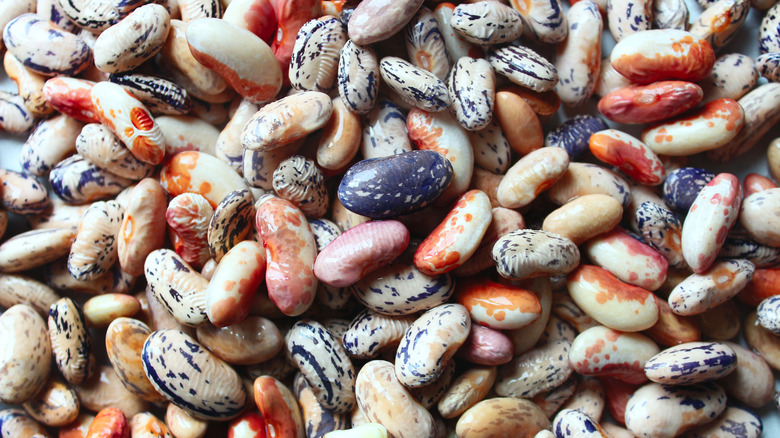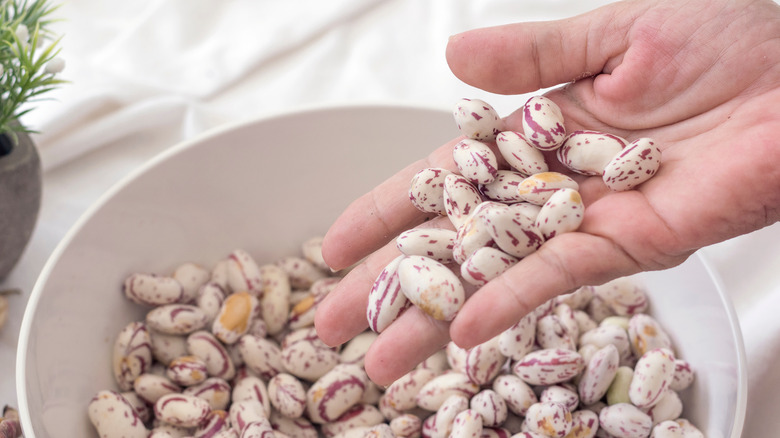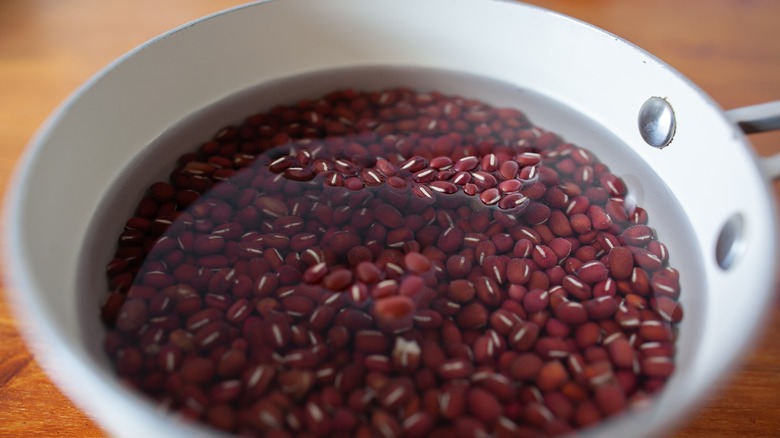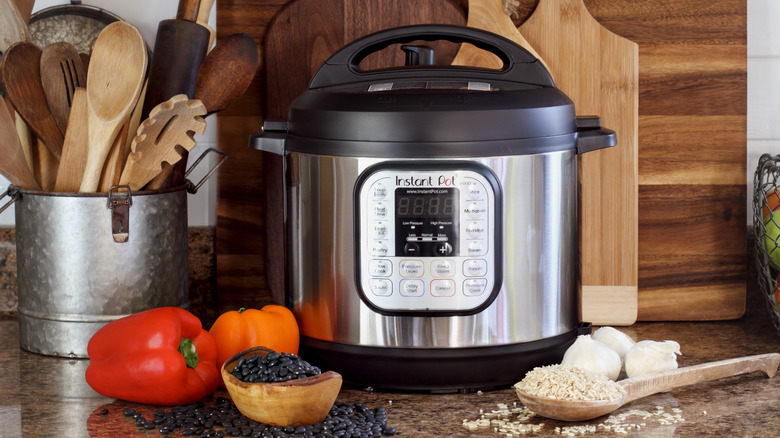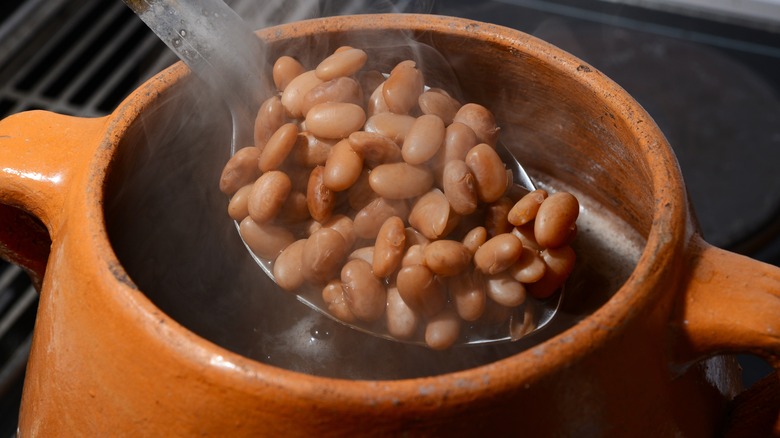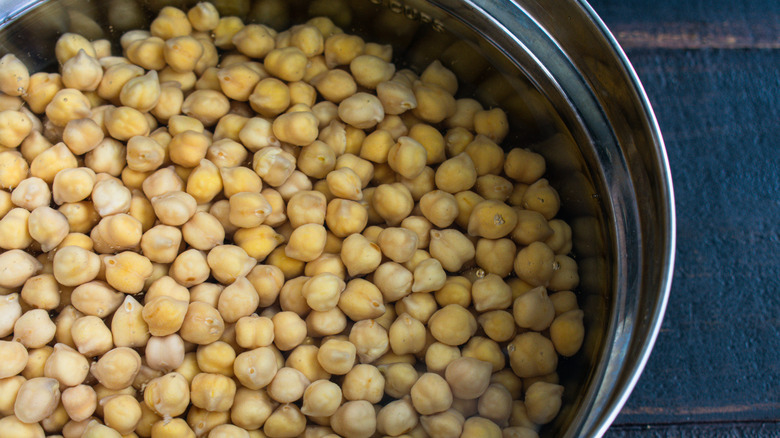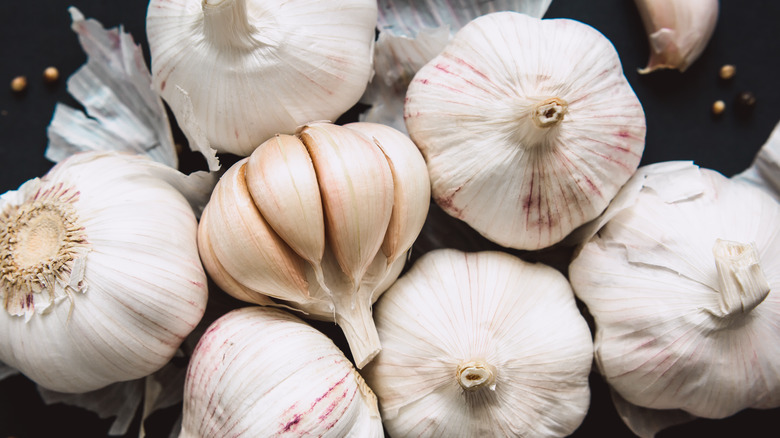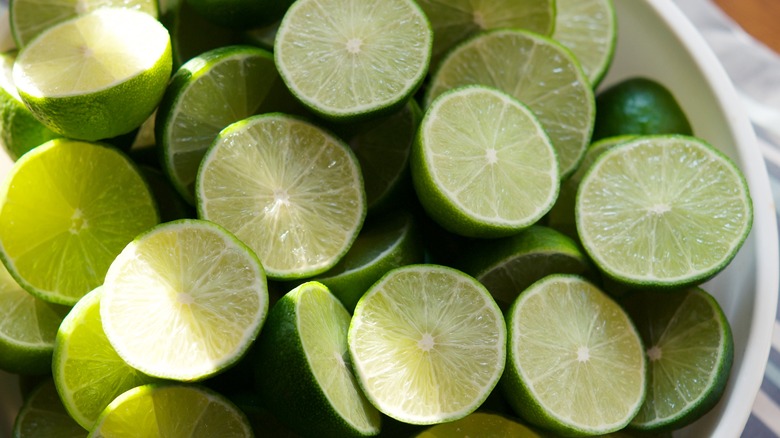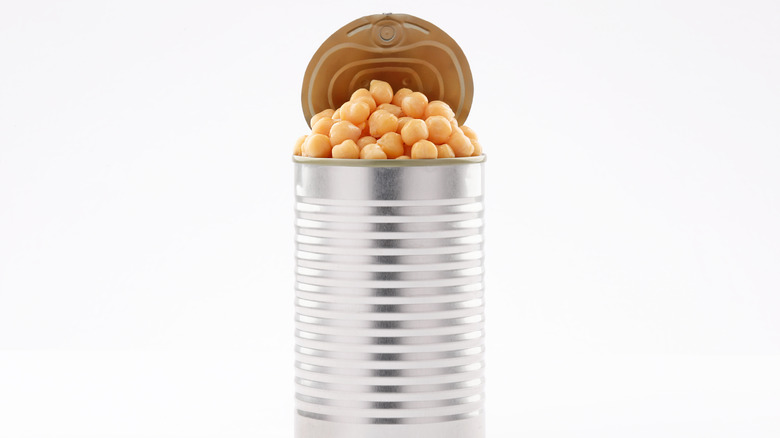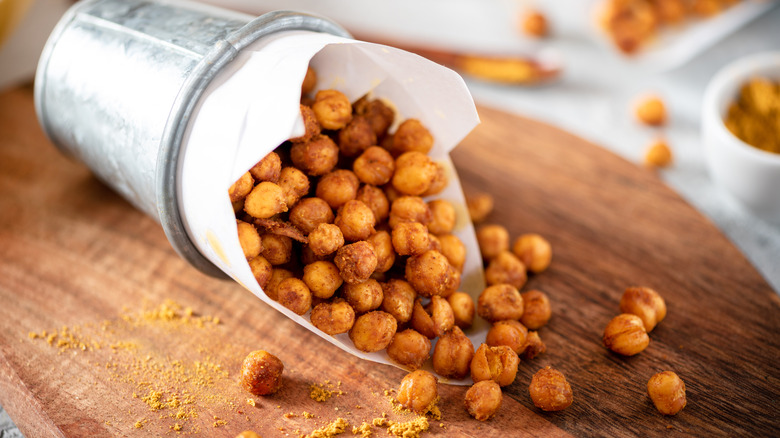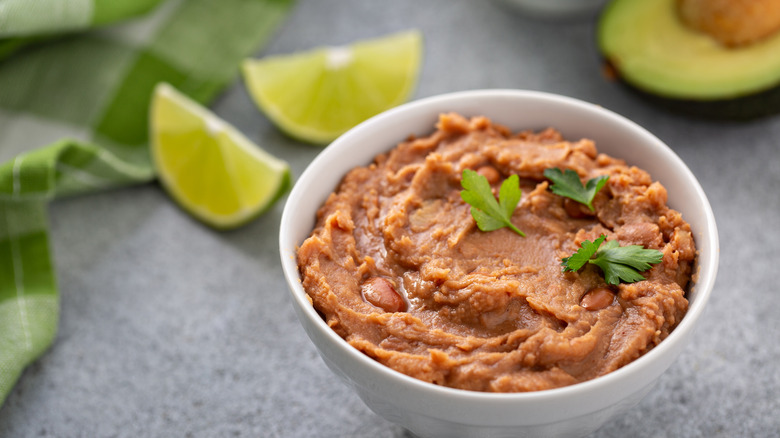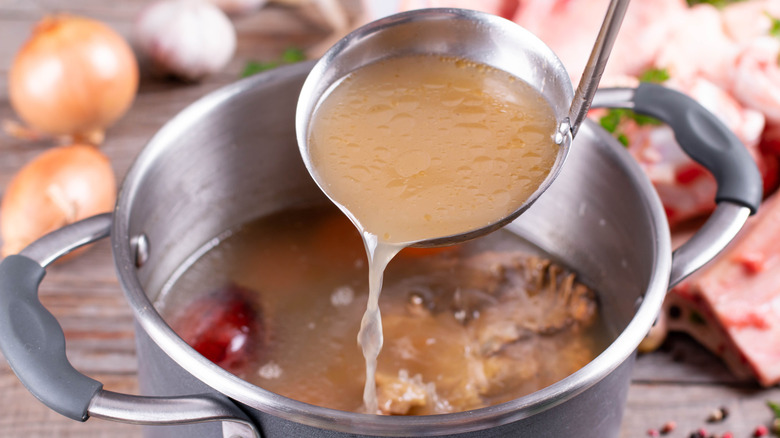11 Tips For How To Cook Beans
Beans are an integral and sustainable part of many cuisines around the world and have been for thousands of years. They can be as varied as people, coming in a wide range shapes and sizes, each with its own unique characteristics and cooking preferences. According to the Mexican Food Journal, beans are one of three key ingredients in Mexican cuisine (alongside corn and chiles) and were one of the country's very first cultivated crops, now home to over 70 varieties.
As we collectively move towards adapting more earth-friendly eating habits, which incorporate more protein-rich vegetarian alternatives into our diets, it is equally important that we know how to cook them so our food tastes good! Whether it's your 100th pot of three-bean chili, or your first, there is always something new to discover within the legume world. Here are some cooking tips on how to make the most out of whatever bean you choose to cook.
Clean those beans
When it comes to using dried beans, there may be many months to several years in between the plant's harvest and its arrival onto your dinner table. Dried beans are an incredibly economical choice, costing a mere $.08 per serving for pinto beans compared to $.34 per serving for its canned counterpart in 2015 (via Bean Institute). When using any dried variety of bean, first begin by rinsing the beans under a cold faucet to remove any dirt or dust. Then, spread them out onto a tray and, using your fingers, sort through the beans in search of pebbles, sticks, leaves or whatever else might have snuck in during the picking, drying, and packing process.
When it comes to "best before" practices, dried beans can be used almost forever if stored well. Given how long dried beans might hang around a shelf or cupboard before seeing action, we recommend washing dried varieties before cooking beans, just like you would with any other produce. Washing is the first step in preparing Miriam Hahn's delicious recipe for vegan Instant Pot red beans and rice.
Soak beans before cooking
Soaking dried beans before cooking is a traditional first step. Soaking can be done in several ways, beginning either on the day you start cooking or the night before for a longer more languishing water bath. Depending on your time constraints, dried beans can be soaked for up to 12 hours or simply overnight by submerging them in plenty cold water.
While there is debate on whether soaking beans before cooking is 100% necessary, it does help increase digestibility of the legumes and insure a fork-tender result, especially if they've been collecting dust in the cupboard or on the grocery store shelf. It can also decrease cooking time, which is always a bonus when trying to get dinner onto the table in a hurry. Go for a relatively quick soak by adding a couple inches of water and salt to season the beans like a brine.
Use a pressure cooker
Open fires and ovens are wonderfully effective methods of cooking dried beans and have been used for thousands of years in thousands of scenarios. However, modern technology shouldn't be discounted when it comes to cooking beans. As the need for quick and easy methods of cooking have become even more crucial, many home and professionals chefs turn to the pressure cooker, like cooking with an Instant Pot. If you have a pressure cooker, you can help significantly reduce the cooking time of your beans, while still achieving great results.
Successful recipe developers are now expanding their recipe methods to include room for the old and the new way of doing things, which means even those of us strapped for time can still have access to a delicious meal. How fast can you go from dried to dinner, you ask? According to Letty's Kitchen, nine minutes is all you need to cook a batch of pre-soaked dried black beans in the Instant Pot. Consider this your formal invitation to browse the dried pulses aisle on your next grocery store run, without worrying about how you'll ever find the time to cook them.
Simmer, don't boil
Help beans retain their shape by treating them gently. Though they may seem indestructible, especially when dried, many varieties of beans such as pinto and black beans have a thin skin and require a gentle heat to help keep it intact. According to the Bean Institute, when cooking beans on the stove, you should simmer rather than boil beans at high heat to reduce the likelihood of splitting and help retain that satisfying firm-but-tender bite.
Becca Hayes of Beans and Whatnot encourages both a gentle heat and gentle touch throughout the cooking process (alongside pre-soaking) to help decrease the likelihood of the skins splitting during the cooking process. Rather than spending your time watching the pot to guarantee it won't boil, you can also choose the cooking equivalent of cruise control with a slow cooker to insure you won't deviate from the low-heat method. A slow cooker will help free up burners on the stovetop, making them available for making accompaniments like a homemade corn tortilla recipe.
Keep beans covered
When using a traditional stovetop method, it is natural for water or broth to evaporate as well as be absorbed by the beans as they cook. Take extra care to keep beans fully submerged by avoiding the water from get too low and exposing the beans to air. Otherwise, you'll be staring down the dried-out-bean barrel, which can be hard to bounce back from.
To help ensure beans stay well protected, cover them with approximately 3 cups of cold water to every cup of dried soaked beans, before bringing to a boil then reducing to a low-and-slow simmer. Keep an eye on the pot and top up with warm water whenever the liquid for cooking beans gets low, pouring until the waterline reaches an inch or two above the top of the pile. Repeat as necessary until beans are fully cooked through and have a tender-yet-firm texture.
Add spices, herbs, and aromatics
Beans are a great vehicle to showcase a wide variety of flavors from around the world. They are so accommodating that beans get along with many other ingredients and spices including onions, salt, bay leaf, garlic, chiles, oregano, parmesan, pancetta and more. Depending on the cuisine you wish to make, cooking your spices in fat (oil, butter, etc.) will create even more depth of flavor before adding the seasonings to your beans.
Greatist recommends four different, but equally delicious, combinations to consider when searching for inspiration for your next pot of beans: Create hot and smoky flavors by using chipotle chile peppers. Middle Eastern-inspired flavors will shine with ingredients like cumin, garlic, and citrus. For a Creole-inspired flavor profile try using oregano, thyme, and paprika.
We recommend layering ingredients strategically in your pot of beans, using a combination of seasonings such as gochujang (Korean chile paste) barbecue sauce, molasses, bacon, and apple cider vinegar to create a satisfying sweet, sour, and spicy combination.
Add acidity
Beans love acidic ingredients like tomatoes, lime, chilies, vinegars, and hot sauces. Acids, found in ingredients like these, help to balance and brighten the earthy flavors and hearty textures many beans possess. However, it is best to add acidity only towards the end or after cooking beans to avoid mistakes like preventing interference. Sometimes acidity can stop beans from fully cooking and becoming tender. However, you can use acids to you advantage in a different way within the process.
Are you beans cooking too quickly? Do you need to slow them down to finish the other components of the meal? Salt Sear Savor says acid might be the perfect way to help beans put the brakes on and slow down the process, avoiding both ill-timed kitchen chaos and split, mushy, or overcooked beans. Just keep best practice timings in mind when reaching for that squeeze of lime or can of tomatoes.
Rinse beans and repeat
A can of beans is one of the healthiest examples of vegan-friendly "fast food" we can think of and the most economical. The average cost of canned beans works out to just $.34 per serving. Having a few on hand is a great way to pull together a quick and easy mid-week meal to make with beans.
When reaching for a can of beans, rather than dried, you'll want to drain the slightly gelatinous, salty water and then rinse your beans under cool running water to remove any excess salt. This leaves a blank canvas ready for all the spices, sauces, seasonings your heart (and mouth) desires. However, if you're opening up a can of chickpeas, you may want to save the liquid, known as aquafaba, which is an incredibly useful vegan egg substitute. It's used widely across home and professional vegan bakers to make a variety of treats that can accommodate for a plant-based diet.
Dry beans before roasting
Roasting canned beans is a fantastic way to play with texture while highlighting the legume's nutty, earthy flavors. Roasting beans, such as chickpeas, also makes for a satisfying plant-based snack that is high in protein and fiber, which work together to keep you feeling satisfied and energized in between meals.
To achieve the perfect crispy, crunchy outside while maintaining a creamy, meaty texture inside, there are a few things you'll want to remember. Firstly, rinse whatever canned beans you are using. Once thoroughly rinsed, pat them dry with a paper towel to remove any excess water. During the roasting process of legumes to chicken to vegetables, water on the surface of the skin will work against the crisping process by creating steam instead. This is why it is often suggested to salt water-rich vegetables like eggplant to draw out excess water before cooking.
We suggest seasoning beans generously for a spicy roasted garbanzo bean recipe with smoked paprika, cumin, black pepper, garlic powder, and salt, along with plenty of oil, before popping them onto a baking tray and into the oven at 350 degrees Fahrenheit for around 45 minutes until crispy and golden.
Make refried beans
Once you've made a batch of delicious homemade beans, there is so much you can do with the results! Not just for chiles, tacos, or over rice, beans can also be refried and turned into homemade bean and cheese burrito or scooped onto nachos and tostadas. Plus, home cooking is so much tastier and, likely, more nutritious than the canned kind.
Once more, this doesn't just have to be reserved for pinto beans; try it with black-eyed peas, a recipe adapted from the Southern Foodways Alliance Community Cookbook. An easy recipe for refried beans can be made from canned beans, adding them into the pan of sautéed onions, garlic, and jalapeños before mashing.
Once you've made your own batch of refried beans, try spreading them onto a partially fried tortilla along with cheese, lettuce, and salsa to create a delicious Oaxacan street food called tlayuda.
Save the cooking broth
Would you make a stew or soup only to save the meat and vegetables and throw out the broth? Of course not! The same is true when it comes to making beans. The broth can be used to maximize flavors just like a beef or chicken stock, says Foodsguy, by storing cooking juices from your beans and freezing the broth for up to six months. The site explains to fill a freezer bag halfway with broth or about 1 inch from the top of a container to allow for expansion.
To reheat your beans, adding a ladle of cooking water helps to deepen flavors as well, taking your beans to a whole new level of taste and satisfaction. Treat the cooking stock much like the base for a hearty and satisfying soup by adding in your aromatics, then cooking the beans and any other ingredients such as rice, directly in the stock to create rich and flavorful soups like this Mexican Rice Soup.
